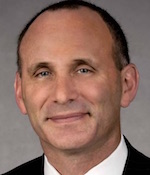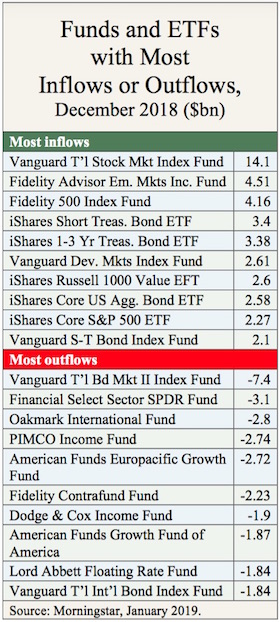
Hundreds, maybe thousands, of academic papers in the field of retirement finance are written, presented at conferences, and published in journals every year, and it grieves me to know that I don’t even hear about most of them, let alone get a chance read them. But I try to keep up.
Here are ten of the articles that I read in 2018 that held my attention all the way through. Most of them came from the National Bureau of Economic Research, which sends me links to a fresh batch of its “working papers” twice a month or so. All of them made me look at the world, or at least the financial and retirement worlds, in a new way. I tried to condense them without losing the gist. You’re bound to find at least one or two of them useful.
Tomlinson, an advisor and actuary, proposes three income-enhancing products that retirees need but can’t find today: A bond ladder that would finance a delay of Social Security benefits to age 70; a single premium immediate annuity (SPIA) that offers inflation-protection for 11% less than the current cost; and a SPIA with accelerated benefits for medical expenses.
Social Security delay product
In a hypothetical case, Tomlinson imagines a 66-year-old individual with $750,000 in a 401(k) wants to retire immediately but delay Social Security claiming to age 70, when the benefits will be 32% higher ($31,680 vs. $24,000). To bridge the gap, an investment company could offer a ladder of Treasury Inflation Protected Securities (TIPS) at age 66 that would provide inflation-adjusted income until age 70. Assuming zero yield on TIPS, the TIPS ladder would cost about $127,000 and payout an inflation-adjusted $31,680 each year.
Improved inflation-adjusted SPIA
To support inflation-adjusted SPIAs less expensively, Tomlinson writes, life insurers could combine a non-inflation-adjusted SPIA with swap transactions that would substitute TIPS for regular Treasury bonds. The effect would be to create synthetic inflation-adjusted bonds with the same credit-spreads that insurers achieve on their regular fixed-income investing. Instead of costing $298,000, a $13,320-a-year inflation-adjusted SPIA would cost about $265,000. That’s a price reduction of 11% or $33,000 more liquidity for the retiree.
Life Care Annuity
Borrowing an idea from economist Mark Warshawsky (relias.com), Tomlinson proposes a standard SPIA but would pay an additional pop-up monthly income if the annuitant needed long-term care (that is, lacked two or more activities of daily living or suffering significant cognitive impairment and needed at least 90 days of care). The pop-up income could be set to double or triple the basic SPIA payouts, and the product could be offered with minimal underwriting because of the close correlation between potential LTC need and diminished longevity. “It might well be feasible to build a product that would be competitive with today’s inflation-adjusted SPIA pricing and provide the significant addition of an LTC pop-up benefit,” Tomlinson writes.
Do you remember August 15, 1971? Richard Nixon ended the gold standard that day. Faced with rising inflation, a growing trade deficit, and the costs of the Vietnam War and Great Society social spending, he hoped to avoid raising interest rates and, in turn, avoid a recession.
The maneuver, which ended the Bretton Woods agreement, helped Nixon win reelection in 1972. But the next decade was financially ugly: a weaker dollar, the Arab oil embargo, the bear market of 1974-75, a rising cost-of-living, Volcker’s defibrillating rate shock and the 1982 recession. Who knew it was the prelude to a sensational bull market?
Michael D. Bordo, a noted economic historian, was teaching a class at Rutgers the day Bretton Woods collapsed, and urged his students to mark the calendar. In this paper, he compares and contrasts the situation then and now. Again, a US president is toying with tariffs and blaming foreigners for a trade deficit. Again, the dollar’s privileged status as the global reserve currency is at stake. Goldbugs should read this paper. So should someone in the Oval Office.
“Take this job and shove it.” There was a time when people, especially youngish people not yet resigned to the grindstone, enjoyed saying that. But they are oldish now, and, in many cases, feeling pressure to work far into their 60s, so they can save more, spend less, let their shares appreciate and maximize their Social Security benefits.
But this paper has good news for people who didn’t save enough for retirement. By working only three to six months longer, and claiming Social Security later, a person could boost his or her retirement income by as much as increasing retirement contributions by one percentage point over 30 years of employment.
For a 62-year-old, working until age 70 would increase retirement income by at least 40%, and for some individuals by more than 100%. “Deferring retirement by one year allows for an 8% higher standard of living for a couple and the subsequent survivor. The effect compounds for two, three, and four-year work extensions,” the authors write.
“The results are unequivocal,” they add. “Primary earners of ages 62 to 69 can substantially increase their retirement standard of living by working longer. The longer work can be sustained, the higher the retirement standard of living.” (In this case, standard of living is measured by the amount of purchasing power a same-age couple would have if they converted their savings at age 70 to an inflation-adjusted joint-life single premium immediate annuity.
The act of waiting to claim Social Security, as opposed to saving more in one’s 60s or giving investments a few more years to grow, turns out to the game-changer for the under-saved. Claiming Social Security at 66 instead of 62 increases retirement living standard by about one-third, the paper shows. Claiming at 70 instead of 62 increases the retirement living standard by almost 75%. The greater a person’s reliance on Social Security for retirement income, the greater he or she can benefit from retiring later.
A lower-wage worker needs to work only 2.1 months longer to equal the benefit of 30 years of saving an extra percentage point of income. A higher wage earner has to work 4.4 months longer to get the same benefit.
Any advisor who wants to show clients how much they can benefit from working longer and delaying Social Security will find this paper valuable.
Every time someone announces the death of active fund management, someone else invokes Mark Twain and says its demise is highly exaggerated. In a new paper about the psychology that helps drive capital asset prices, Nicholas C. Barberis of the Yale School of Management, comes down in favor of active management.
“An active trading for rational investors, one where investors tilt their portfolios toward low price-to-earnings stocks and gently time the stock market to take advantage of return predictability” is the path to better returns, Barberis writes. As the paper unfolds, you realize that he’s making a case for factor-based investing without saying it too explicitly.
Referring to factor-based funds, he writes, “New financial products have appeared that exploit mispricing” by mechanically buying and selling assets with these characteristics, which have “genuine predictive power.” (See below. The plus and minus signs indicate positive or negative predictive power):
- Past three-year return –
- Past six-month return +
- Past one-month return –
- Earning surprise +
- Market capitalization –
- Price-to-fundamentals ratio –
- Issuance –
- Systematic volatility –
- Idiosyncratic volatility –
- Profitability +
“Factor-based funds may be an attractive addition to a portfolio over and above index funds,” he told RIJ in an email. He refrains from mentioning factor investing in the paper, however, but he recommends them “so long as the fees are low, of course. My understanding is that some of these products do have low fees now – but not all, so some care is needed.”
The paper also describes Barberis’ search for a “unified psychology-based model of investor behavior might take.” He reviews existing literature on behavioral finance and concludes that such a model might combine “extrapolative beliefs” (where expectations about the future are based on past experience) and “gain-loss utility” (the idea that losses hurt more than gains feel good)—a pairing on which little work has been done, he writes.
When working with retired couples, advisors face longevity uncertainties that are more complex than when they work with single retirees. Past research shows, and you’ve probably heard, that there’s a 25% chance that one member of a couple will reach age 90. For that reason, some advisors plan on a 25-year retirement after age 65.
But how long is a couple likely to live together in retirement before one dies (i.e., their joint life expectancy)? And how long might the survivor live as a widow or widower (i.e., the survivor life expectancy)? These are slippery projections, and the authors of this paper, “The Life Expectancy of Older Couples and Surviving Spouses,” try to get a reasonably firm grip on them.
For couples, analogous measures are the expected years both spouses will be alive (joint life expectancy) and the expected years the surviving spouse will spend as a widow or widower (survivor life expectancy).
In a hypothetical example, the authors consider a wife, 60, whose husband is 62. In 2010, her life expectancy at that age (the national average) was 24.5 years and her husband’s 20.2 years. But according to this paper, the couple’s joint life expectancy is only 17.7 years. And while her life expectancy is only four years longer than his, if he dies first (a 62% probability), she can expect to live 12.5 more years, to age 90, on average. If she dies first (a 38% probability) he can expect to live another 9.5 years, to 89, on average.
“Using individual life expectancies to calculate summary measures for couples yields substantially misleading results because the mortality distribution of husbands and wives overlap substantially,” the authors write.
Advisors can use these figures to show couples when, on average, the lesser of their Social Security payments could end, and how they might offset the shortfall. Discussions about mortality aren’t easy, but they can be empowering. These figures, interestingly, do not substantiate the perception that elderly couples often die in rapid succession. The averages do suggest that couples should plan for five more years of income than single people.
If you’re an advisor, you’ve surely encountered new clients who say, though perhaps not in so many words, “I’ll buy almost anything you recommend–except an annuity.” Depending on how you roll, you might either avoid the topic altogether or try to overcome their resistance.
But that begs the question: Why are they so resistant? Or, perhaps more constructively, how might an advisor tell which clients would be receptive to an annuity purchase?
In this paper, retirement researchers at UCLA and Duke find that older Americans who perceive annuities to be “fair,” who are concerned about being a burden to their children, and who are relatively less loss-averse, are the ones most likely to buy them.
“By far the strongest of all the individual differences we measured at predicting liking of annuities is the question of whether the individuals think annuities are ‘fair,’ wrote Suzanne Shu and Robert Zeithammer of UCLA and John Payne of Duke, three long-time contributors to research on the so-called “annuity puzzle.”
“From a positive perspective for marketers of these products… this suggests that the annuity puzzle [i.e., the low demand for longevity insurance among retirees] is more a problem of perception that of the financial tradeoffs inherent in the product,” they wrote.
They said that their research conclusions might be useful “for financial planners hoping to help their customers with [their] decumulation challenges.”
To determine perceptions of fairness, the authors first asked several hundred Americans ages 40 to 65 if they considered annuities “Completely unfair,” “Acceptable” or “Somewhat Unfair.” Then they asked them to indicate if they agreed or not with the following statements.
- I feel like I understand the life annuity market well.
- The system behind life annuities should be changed.
- I would avoid companies that sell life annuities if I could.
- It is clear where the money for this product comes from.
- It is fair that the company is allowed to keep the excess funds.
- I feel that I would have too little control over my retirement money if I bought an annuity.
“Prior research on consumer fairness has suggested that judgments of fairness are affected by the way that profits are shared between the firm and consumer, the intentions of the firm, the firm’s perceived wealth and power, and whether underlying costs are variable or fixed. In this project, our fairness measure was a simple one taken directly from Kahneman, Knetsch, and Thaler (1986),” the paper said.
Receptiveness toward annuities was found to be higher among the relatively less loss-averse and those who had a strong wish to protect their heirs. “Survey respondents… who clearly identify a family member as a potential beneficiary are significantly more likely to select annuities,” the paper said. “This intriguing result could suggest instead that individuals who are worried about becoming a burden on family are more open to the idea of annuities.”
It’s well known that people tend to behave less than rationally with their money. Investor behavior after the election of Donald Trump in November 2016 provided fresh evidence of that to three MIT professors, who carefully studied investing trends in the months after that election.
Republican and Democratic investors alike could have seen, objectively, that the economy was likely to boom under a president who favored lower taxes and fewer regulations, the authors hold. In the year after the election, the Dow Jones Industrial Average grew 28.5%, from an already record-breaking base.
But while Republicans shifted into equities after the election, Democratic investors shifted measurably into bonds. The researchers were perplexed. They clearly didn’t think that the Democrats’ gloominess about Trump’s long-term effect on American democracy and the health of the biosphere would overwhelm their investing acumen.
“Our main finding is that (likely) Republicans increase the exposure of their investments to the US stock market relative to (likely) Democrats following the election. Democrats increase their relative holdings of bonds and cash-like securities,” the authors wrote.
In theory, market participants typically agree about the probability of different states of the world, the researchers wrote. But, in practice, they showed, different people have different “models of the world,” and make investment decisions on that basis.
The study was based on trading activity by individual retirement account holders at an unnamed major financial institution. Their average household income was $101,600 and the median was $78,000. The average investor in the study had $156,500 in investable wealth, of which 81% was in retirement accounts. The researchers did not include the wealthiest or poorest 10% of the population. The sample captured 40% of the US population and 47.3% of retirement wealth.
Moshe Milevsky, the well-known annuity expert at York University’s Schulich School of Business, introduces the fictional characters Heather (in glowing health) and Simon (in miserable health) to illustrate the point that people without long life expectancies can still get value from broad-based pensions like Social Security—but not as much from individual retail annuities, which are purchased voluntarily.
Even though healthy people receive more on average from a defined benefit (DB) pension system like Social Security—the healthy obviously live longer and collect benefits longer—shorter-lived people still get an important benefit because their life expectancies are less predictable, statistically speaking. Ironically, this gives them more “longevity risk” than healthy people, whose death rate clearly spikes in the mid-80s.
The message is timely. The US approaches a reckoning over Social Security reform. As policymakers contemplate raising the initial age of eligibility (62) and or the full retirement age (67) to save money, the impact on people with shorter life expectancies will be an issue. Meanwhile, many individual Boomers (of varying life expectancies) have difficulty gauging if retail annuities are a “good deal” or not. This paper can inform discussions of both issues.
A $16 billion annual federal subsidy for the asset management industry is hidden inside our system of incentivizing retirement savings with tax-deferral, according to this paper. That’s roughly the amount of revenue, the authors say, that the fund industry would not be collecting in fees if the US used a Roth-style system where contributions to retirement accounts were taxed up front rather than after age 70½.
“Record keepers, asset managers, and financial advisors charge fees for running retirement plans, managing assets, and advising clients,” write Landoni, of Southern Methodist University, and Zeldes, of Columbia. “These fees are typically charged as a percentage of assets under management (AUM). By deferring tax revenue with a traditional scheme, the government pays investment fees on the substantial amount of assets that sit in retirement accounts waiting to pay future taxes.”
The authors estimate that “substantial amount” at about $3 trillion. “The U.S. government’s implicit account is large,” according to the paper. “We estimate its size as the total amount of tax-deferred assets in DC plans and IRAs ($14.4 trillion) times 20%, a reasonable estimate of the average marginal tax rate in retirement, leading to our title figure of $2.9 trillion of retirement assets.
“We conservatively estimate fees to be about 72 basis points (bps) based on the lowest asset-weighted figures available. We assume that 21% of fees paid by the government are recovered via corporate taxation of the asset managers. Multiplying $2.9 trillion by .72%×(1 – .21), we reach our estimate of $16 billion per year—a cost for the government, and an annual subsidy to the asset management industry.”
After the 2008 financial crisis, the Fed reduced interest rates to historically low levels. Not long after that, the public’s interest in maximizing Social Security benefits seemed to spike and advisors touted their expertise in Social Security claiming strategies. That was no coincidence, according to the authors of this paper.
“When expected returns are high, the worker can claim early Social Security benefits without needing to withdraw as much from his retirement assets which continue to earn higher returns for a while longer,” write Olivia Mitchell, the director of the Pension Research Council at the Wharton School, and her German co-authors.
“But when the real interest rate is low, a worker can delay claiming Social Security in exchange for higher lifelong benefits, and the cost of taking more from his retirement account to support consumption is lower. …By delaying claiming, people can maximize the actuarial net present value of their lifetime Social Security benefits in times of low returns. But when returns are higher, claiming early maximizes the net present value of benefits.
The incentive to work and save is higher when interest rates are higher, they find. “When the interest rate is low, people work fewer hours per week early in life, compared to workers in the higher interest environment. For example, women work two hours per week less between ages 25-60 than they do in the two percent [real] interest rate scenario. The reason is that, in the higher return scenario, it is more attractive to build up savings early in life as these can grow at the higher rate.
“More work effort then generates higher labor income, and because of the progressive tax system, this results in a larger allocations to the tax-exempt retirement accounts. In addition, returns earned on assets held inside the 401(k) plan are tax-free. This second ©advantage is, of course, smaller in a zero return environment. Accordingly, when interest rates are low (or high), workers devote more (or less) of their savings to non-retirement accounts.”
© 2019 RIJ Publishing LLC. All rights reserved.



















